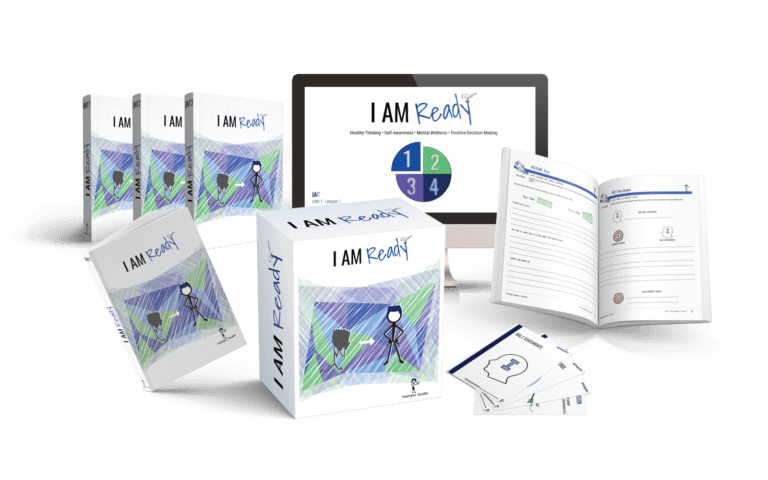Teach · Coach · Mentor

I AM READY
Curriculum
I AM READY

Unit 6: How Are You Coping?
Guiding Questions:
- What are the styles of coping?
- Are my coping skills constructive or destructive?
- How can I replace destructive coping skills with healthy coping skills?
Unit Description:
We cannot avoid stressful life events. We can, however, control how we cope with life’s stressful events. In Unit 6, students identify major stressors and evaluate the impact of these events on their daily lives.
Learners explore the four types of Coping Styles and identify their Coping Style preferences. Students explore coping habits and how impulsive coping behaviors can lead to unhealthy coping habits.
Student create a Coping Plan to evaluate the benefits and consequences of impulsive coping behaviors and practice the REACT Tool. The REACT tool helps learners stop impulsive reactions and helps learners consider healthy alternatives in moments of stress and volatility.
Lesson Overviews
Lesson One
Overview
Learners examine stress and coping. Learners examine the four types of Coping Styles and take an inventory to determine their preferred style. Learners review and create TRY Goals and discuss highs and lows with their Accountability Partners.
Critical Activities
- Take A Stand
- Accountability Partners
- Climb Our Mountain
- Rules for Living
- Transformation Circle
- Whip Around
Objectives
- Define Rules for Living
- Understand how Rules for Living are formed and applied
- Define Forces of Distortion
- Understand cognitive distortions
- Acknowledge challenges and successes
- Review and evaluate progress for personal records
- Set a TRY Goal
Learning Targets
- Rules for Living are automatic assumptions about how the world operates.
- A Daily RFL is a mental shortcut we use to make decisions in everyday routine experiences and events.
- A Protective RFL is a mental shortcut that helps us make decisions in a potentially threatening or unusual situation.
- An RFL that is distorted and applied to inappropriate situations is called Distortion.
- A distorted belief creates distorted thoughts, feelings, and actions.
- Distressing experiences and trauma can distort my Rules for Living and my thoughts, feelings, and actions.
Lesson Two
Learners explore self-control challenges and establish their WHY for course participation. This Happened! and Tracking My Day Tools reflective tools are introduceOverview
Learners examine coping habits, impulsivity and the short- and long-term benefits and consequences of specific coping behaviors. Learners complete a Coping Plan and practice the REACT tool for managing impulsive behavior.
Critical Activities
- Words I Wish I Wrote
- Tie it Together
- RFL Cycle Walk
- This Happened!
- Tracking My Day
- A Picture Speaks a Thousand Words
Objectives
- Understand how Rules for Living are developed
- Connect Rules for Living to internal events
- Identify thoughts, behaviors, and actions of others through roleplay
- Challenge cognitive distortions with Six Seconds to Ready
Learning Targets
- My RFLs influence my experiences. My experiences reinforce my RFLS.
- The RFL Cycle creates a powerful mental habit that impacts all aspects of my daily life.
- Distorted RFLs create distorted and irrational thoughts.
Lesson Three
Overview
Learners explore stress management through Today & Tomorrow Episode 6, complete their first Empathy Map, and practice their first guided meditation.
Critical Activities
- Tie it Together
- Tune in! Today & Tomorrow
- T&T Draw it!
- This Happened!
- Tracking My Day
- Back-to-Back
Objectives
- Identify thoughts, behaviors, and actions of others through story
- Identify I AM Ready tools for specific situations and scenarios
- Practice applying tools to characters in story
Learning Targets
- Targets and Statements are reviewed in the Transformation Circles and Accountability Partners.
Lesson Four
Overview
Learners explore the relationship between coping habits, Rules for Living, and Thinking Errors.
Critical Activities
- Whip Around
- Free Throw Game
- Take a Stand
- Transformation Circle
- Accountability Partners
- Create a TRY Goal
- A Picture Speaks a Thousand Words
Objectives
- Review inner voice
- Identify thoughts, behaviors, and actions of others through story
- Practice challenging cognitive distortions with Six Seconds to Ready
- Build positive internal scripts
Learning Targets
Targets and Statements are reviewed in the Transformation Circles and Accountability Partners.
CBT Terms and Tools
Terms:
- Rules for Living
- Daily Rules for Living
- Protective Rules for Living
- Distortion
- Distress
- Trauma
- Chronic Stress
IAR Tools:
- This Happened! event journal
- Tracking My Day record
- Learning Targets
- Big I Statements
- ‘Above the Bar’ behaviors
- ‘Below the Bar’ behaviors
- Climb Our Mountain journal
- RFL Cycle Walk
- Six Seconds to Ready
